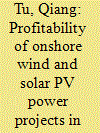|
|
|
Sort Order |
|
|
|
Items / Page
|
|
|
|
|
|
|
| Srl | Item |
| 1 |
ID:
176905


|
|
|
|
|
| Summary/Abstract |
Achieving grid parity of solar photovoltaic (PV) power in China has great implication for the future energy system transformation. In this work whether and when, and under what conditions the grid parity can be achieved are assessed, and especially the role of Tradable Green Certificate (TGC) policy in achieving the grid parity is explored. We first estimate the future levelized cost of electricity (LCOE) of solar PV power using learning curve method, and then by comparing it with on-grid price of coal-fired power, the grid parity of solar PV power is determined. Specifically, using a panel dataset consisting of information of 541 solar PV power projects over the period of 2010–2016, the learning rate of PV power is estimated, based on which the future LCOEs are estimated. The results show that the LCOE of PV power decreases from 0.4631 CNY/kWh in 2018 to 0.3345 CNY/kWh in 2030 under the baseline scenario of the cumulative installed capacity, and the grid-parity of solar PV power may be achieved between 2023 and 2025. With the TGC policy being implemented, the grid parity can be achieved earlier. Specifically, with the TGCs price reaching 100 CNY, the grid parity can be achieved in 2020.
|
|
|
|
|
|
|
|
|
|
|
|
|
|
|
|
| 2 |
ID:
167037


|
|
|
|
|
| Summary/Abstract |
Despite the rapid development of renewable energy power in China, the sector is facing significant challenges in the form of declining feed-in tariffs (FIT) and serious curtailment problems. However, in the long-run the nationwide carbon emission trading system may provide a new economic incentive to invest in renewable energy projects in China. Against this background, we assess the effect of gradually declining FIT on the profitability of renewable energy power projects in China and evaluate the potential of a carbon price to overcome the resulting financial gap. Based on a dataset of 1552 onshore wind and 414 solar PV power projects from 2010 to 2015, we first estimate the levelized cost of electricity (LCOE) for onshore wind and solar PV investments. We then estimate profitability using different carbon prices and varying levels of FIT. Our findings suggest that revenues from selling certified carbon emissions reductions in the carbon market can compensate partially for the revenue losses caused by declining FIT. However, the current carbon prices of China's carbon-emission trading pilot schemes are not sufficiently high to compensate for revenue losses. For 90% of PV projects to remain profitable with lower FIT, the carbon price would need to rise to USD 64/t of CO2. For on-shore wind plants, lower carbon price levels of up to USD 41/t CO2 would be sufficient.
|
|
|
|
|
|
|
|
|
|
|
|
|
|
|
|
| 3 |
ID:
181471


|
|
|
|
|
| Summary/Abstract |
The outbreak of COVID-19 pandemic has increased the production costs of renewable energy facilities and undermines the profitability of renewable energy investment. Green finance polices, e.g. carbon pricing, tradable green certificate (TGC) and green credit, can provide low-cost finances and counteract the adverse effects of COVID-19 pandemic. In this work, the generation costs of offshore wind power before and after the COVID-19 pandemic in China are analyzed using the data of 97 offshore wind power projects implemented in the period of 2014–2020, and the effect of green finance policy on the generation cost and the project profitability are evaluated. The results show that the average levelized cost of electricity (LCOE) of offshore wind power decreased from 0.86 CNY/kWh in 2014 to 0.72 CNY/kWh in 2019, while it increased to 0.79 CNY/kWh in 2020, i.e. 10.85% increase relative to that in 2019. With the average carbon price of 50 CNY/t CO2, the average TGC price of 170 CNY and the green-credit policy being introduced, the average LCOE decreases to 0.76 CNY/kWh, 0.67 CNY/kWh and 0.74 CNY/kWh respectively. The green finance policy mix is still necessary to support the offshore wind power investment during the Covid-19 pandemic.
|
|
|
|
|
|
|
|
|
|
|
|
|
|
|
|
|
|
|
|
|